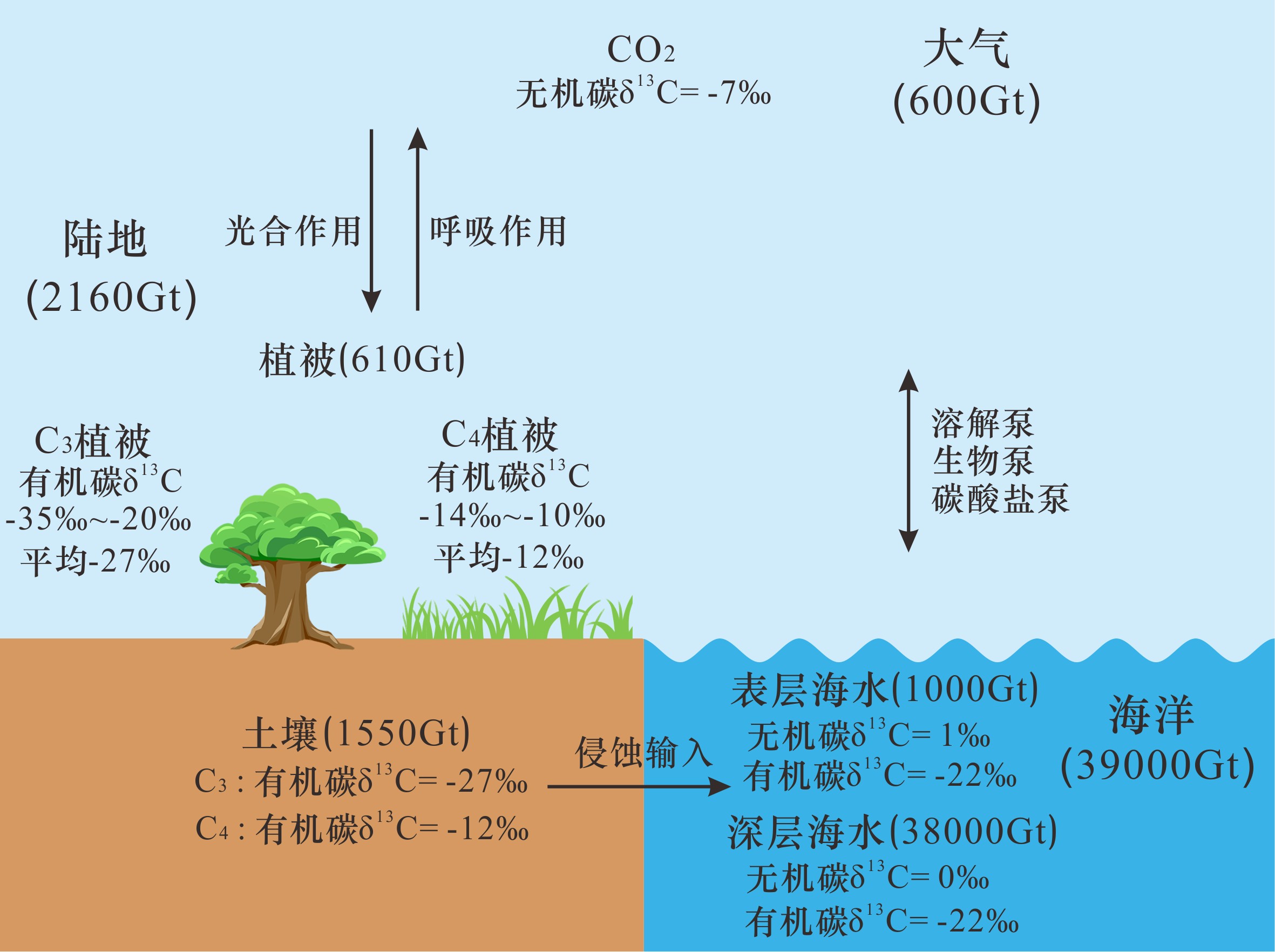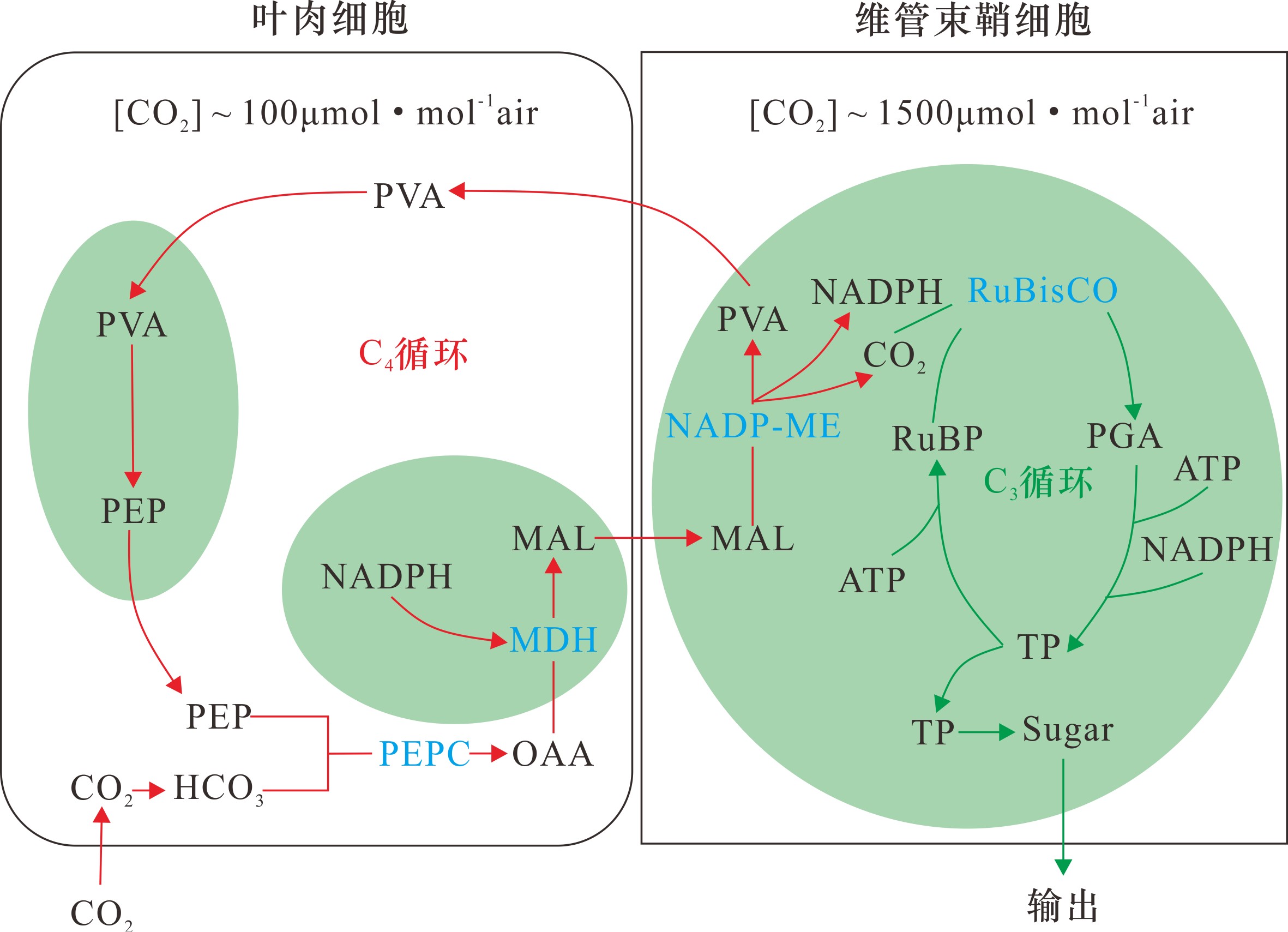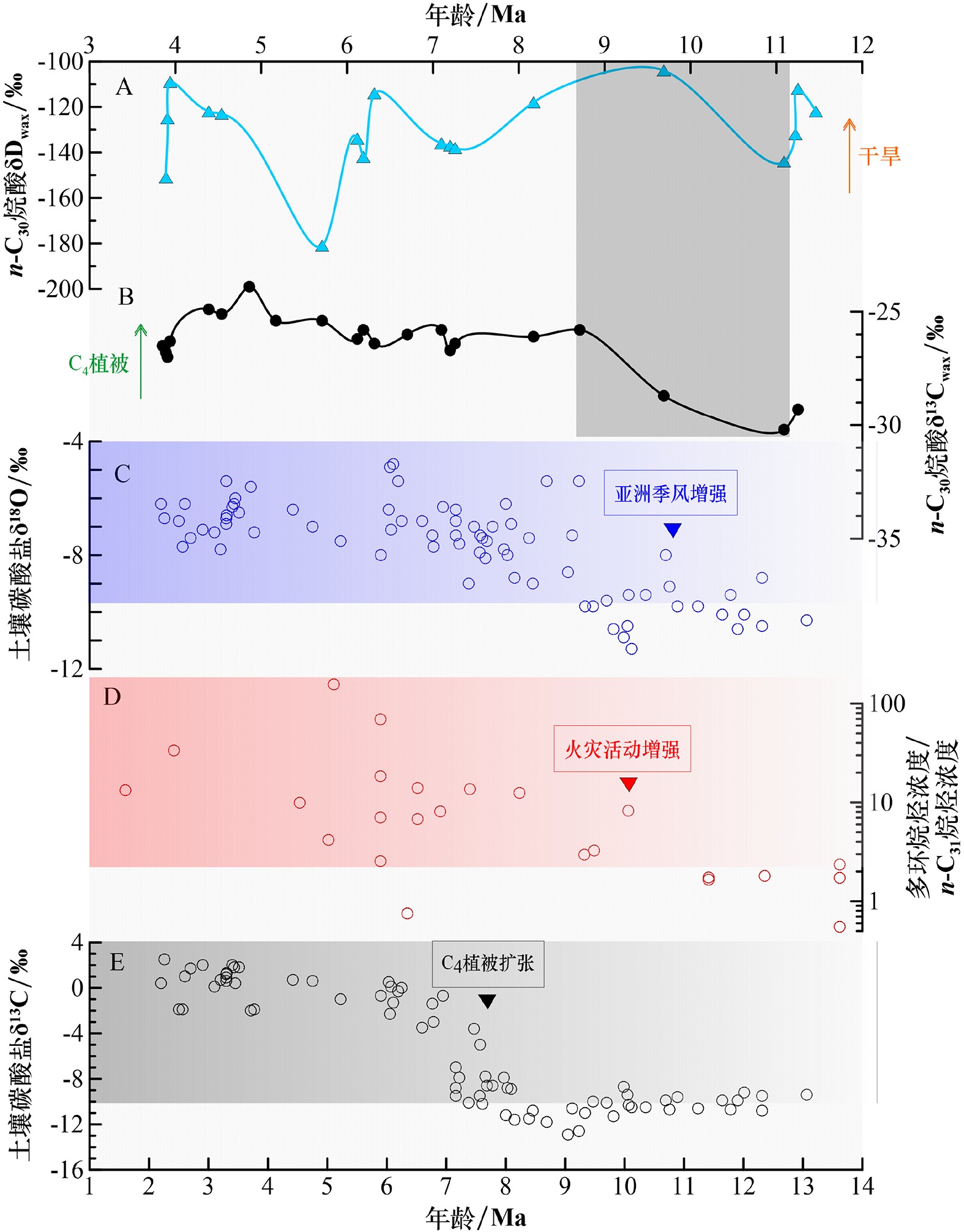The Late Miocene C4 vegetation expansion and its relation with the partial pressure of carbon dioxide in atmospheric
-
摘要:
大量陆地与海洋的地质记录证实了晚中新世C4植被发生全球异步扩张,最早在10 Ma左右开始于非洲东部与西北部,随后8~6 Ma左右大范围传播至南亚、南非、北美等地区,最终C4植被于上新世发生再次扩张,基本形成现今的生态格局。对于晚中新世C4植被扩张的解释至今仍存在疑惑,主要围绕气候变化与CO2展开争论。最新的大气二氧化碳分压(pCO2)重建记录显示,大气CO2浓度在晚中新世时期处于下降的趋势。综合考虑晚中新世C4植被的扩张区域,地质记录重建的大气CO2浓度与数值模拟实验中形成C4植被扩张所需的大气CO2浓度在数值上相吻合,突出了大气CO2浓度变化对晚中新世C4植被扩张的作用。由于现有的大气CO2浓度重建记录的分辨率较低,不管是在趋势上还是数值上,其可靠性都有待商榷,未来应该专注于晚中新世可靠的高分辨率大气CO2浓度记录的重建,这是解开晚中新世大气CO2与C4植被扩张关系的关键,对研究未来气候变化具有指导意义。
Abstract:A large number of terrestrial and marine geological records has confirmed the global asynchronous expansion of C4 vegetation in Late Miocene, which started in the eastern and northwestern Africa as early as 10 Ma, and then spread to South Asia, South Africa, North America and other areas in a wide range around 8~6 Ma. Finally, the C4 vegetation expanded again in Pliocene, and the present ecological pattern is basically formed. However, the mechanism of the C4 vegetation expansion in Late Miocene still remains unclear, with the major debate concentrating on climate and CO2 changes. The recent atmospheric partial pressure pattern of carbon dioxide (pCO2) reconstructed shows a downward trend of the atmospheric CO2 concentration during Late Miocene. Considering the late Miocene C4 vegetation expansion areas, the proxy-derived atmospheric pCO2 is consistent with that needed for the C4 vegetation expansion in a numerical simulation experiment, which highlights the role of the atmospheric pCO2 in the Late Miocene C4 vegetation expansion. The low time resolution of the existed proxy-derived atmospheric pCO2 records determines their low reliability on both the long-term trend and the absolute values. The next step should focus on the reconstruction of the reliable high-resolution record of the atmospheric pCO2 for Late Miocene, the key to unlock the relationship between the atmospheric pCO2 and the C4 vegetation expansion in Late Miocene, which has guiding significance for the study of future climate change.
-
Key words:
- C4 vegetation expansion /
- atmospheric pCO2 /
- seasonal climate /
- numerical simulation /
- Late Miocene
-

-
图 3 C3/C4植被参与的全球碳循环过程[60]
Figure 3.
图 4 C4植物的CO2浓缩机制[27]
Figure 4.
表 1 古大气pCO2的重建方法
Table 1. Methods for reconstruction of ancient atmospheric pCO2
方法 相关公式 说明 参考文献 古植物叶片的气孔指数 
实验培养的银杏气孔指数SI与CO2浓度的经验关系 Retallack, et al[36] 古土壤碳酸盐的碳同位素 
S(z)是深度为z的土壤生物呼吸产生的CO2浓度,δ13Cs、δ13Cr、δ13Ca分别是土壤总CO2、土壤生物呼吸产生CO2、大气CO2的碳同位素组成 Cerling, et al[37] 浮游藻类生物标志物的碳同位素 
εp为总碳同位素分馏值,b为所有影响总碳同位素分馏的生理作用值,εf为碳固定过程的分馏系数 Jasper, et al[40] 浮游有孔虫壳体的硼同位素 
KB*、αB是硼酸反应的电离常数与分馏系数,δ11BT是海水总硼的硼同位素组成,δ11BB(OH)4-是海水硼酸根的硼同位素组成;求[CO2]还需结合碳酸盐体系第二个参数 Zeebe, et al[43] -
[1] Haq B U, Worsley T R, Burckle L H, et al. Late Miocene marine carbon-isotopic shift and synchroneity of some phytoplanktonic biostratigraphic events [J]. Geology, 1980, 8(9): 427-431. doi: 10.1130/0091-7613(1980)8<427:LMMCSA>2.0.CO;2
[2] Bickert T, Haug G H, Tiedemann R. Late Neogene benthic stable isotope record of Ocean Drilling Program Site 999: implications for Caribbean paleoceanography, organic carbon burial, and the Messinian Salinity Crisis [J]. Paleoceanography, 2004, 19(1): PA1023.
[3] Diester-Haass L, Billups K, Emeis K C. Late Miocene carbon isotope records and marine biological productivity: Was there a (dusty) link? [J]. Paleoceanography, 2006, 21(4): PA4216.
[4] Hodell D A, Venz-Curtis K A. Late neogene history of deepwater ventilation in the Southern Ocean [J]. Geochemistry, Geophysics, Geosystems, 2006, 7(9): Q09001.
[5] Drury A J, John C M, Shevenell A E. Evaluating climatic response to external radiative forcing during the late Miocene to early Pliocene: New perspectives from eastern equatorial Pacific (IODP U1338) and North Atlantic (ODP 982) locations [J]. Paleoceanography, 2016, 31(1): 167-184. doi: 10.1002/2015PA002881
[6] Drury A J, Westerhold T, Frederichs T, et al. Late Miocene climate and time scale reconciliation: Accurate orbital calibration from a deep-sea perspective [J]. Earth and Planetary Science Letters, 2017, 475: 254-266. doi: 10.1016/j.jpgl.2017.07.038
[7] Tian J, Ma X L, Zhou J H, et al. Subsidence of the northern South China Sea and formation of the Bashi Strait in the latest Miocene: Paleoceanographic evidences from 9-Myr high resolution benthic foraminiferal δ18O and δ13C records [J]. Palaeogeography, Palaeoclimatology, Palaeoecology, 2017, 466: 382-391. doi: 10.1016/j.palaeo.2016.11.041
[8] Tian J, Ma X L, Zhou J H, et al. Paleoceanography of the east equatorial Pacific over the past 16 Myr and Pacific–Atlantic comparison: High resolution benthic foraminiferal δ18O and δ13C records at IODP Site U1337 [J]. Earth and Planetary Science Letters, 2018, 499: 185-196. doi: 10.1016/j.jpgl.2018.07.025
[9] Drury A J, Lee G P, Gray W R, et al. Deciphering the state of the late miocene to early pliocene equatorial pacific [J]. Paleoceanography and Paleoclimatology, 2018, 33(3): 246-263. doi: 10.1002/2017PA003245
[10] Quade J, Cerling T E, Bowman J R. Development of Asian monsoon revealed by marked ecological shift during the latest Miocene in northern Pakistan [J]. Nature, 1989, 342(6246): 163-166. doi: 10.1038/342163a0
[11] Cerling T E, Wang Y, Quade J. Expansion of C4 ecosystems as an indicator of global ecological change in the late Miocene [J]. Nature, 1993, 361(6410): 344-345. doi: 10.1038/361344a0
[12] Cerling T E, Harris J M, Macfadden B J, et al. Global vegetation change through the Miocene/Pliocene boundary [J]. Nature, 1997, 389(6647): 153-158. doi: 10.1038/38229
[13] Holbourn A E, Kuhnt W, Clemens S C, et al. Late Miocene climate cooling and intensification of southeast Asian winter monsoon [J]. Nature Communications, 2018, 9(1): 1584. doi: 10.1038/s41467-018-03950-1
[14] Kump L R, Arthur M A. Interpreting carbon-isotope excursions: Carbonates and organic matter [J]. Chemical Geology, 1999, 161(1-3): 181-198. doi: 10.1016/S0009-2541(99)00086-8
[15] Latorre C, Quade J, Mcintosh W C. The expansion of C4 grasses and global change in the late Miocene: Stable isotope evidence from the Americas [J]. Earth and Planetary Science Letters, 1997, 146(1-2): 83-96. doi: 10.1016/S0012-821X(96)00231-2
[16] Behrensmeyer A K, Quade J, Cerling T E, et al. The structure and rate of late Miocene expansion of C4 plants: Evidence from lateral variation in stable isotopes in paleosols of the Siwalik Group, northern Pakistan [J]. GSA Bulletin, 2007, 119(11-12): 1486-1505. doi: 10.1130/B26064.1
[17] Passey B H, Ayliffe L K, Kaakinen A, et al. Strengthened East Asian summer monsoons during a period of high-latitude warmth? Isotopic evidence from Mio-Pliocene fossil mammals and soil carbonates from northern China [J]. Earth and Planetary Science Letters, 2009, 277(3-4): 443-452. doi: 10.1016/j.jpgl.2008.11.008
[18] Uno K T, Cerling T E, Harris J M, et al. Late Miocene to Pliocene carbon isotope record of differential diet change among East African herbivores [J]. Proceedings of the National Academy of Sciences of the United States of America, 2011, 108(16): 6509-6514. doi: 10.1073/pnas.1018435108
[19] Fox D L, Honey J G, Martin R A, et al. Pedogenic carbonate stable isotope record of environmental change during the Neogene in the southern Great Plains, southwest Kansas, USA: Carbon isotopes and the evolution of C4-dominated grasslands [J]. GSA Bulletin, 2012, 124(3-4): 444-462. doi: 10.1130/B30401.1
[20] Dupont L M, Rommerskirchen F, Mollenhauer G, et al. Miocene to Pliocene changes in South African hydrology and vegetation in relation to the expansion of C4 plants [J]. Earth and Planetary Science Letters, 2013, 375: 408-417. doi: 10.1016/j.jpgl.2013.06.005
[21] Hoetzel S, Dupont L, Schefuß E, et al. The role of fire in miocene to pliocene C4 grassland and ecosystem evolution [J]. Nature Geoscience, 2013, 6(12): 1027-1030. doi: 10.1038/ngeo1984
[22] Polissar P J, Rose C, Uno K T, et al. Synchronous rise of African C4 ecosystems 10 million years ago in the absence of aridification [J]. Nature Geoscience, 2019, 12(8): 657-660. doi: 10.1038/s41561-019-0399-2
[23] Neupane P C, Gani M R, Gani N D, et al. Neogene vegetation shift in the Nepalese Siwalik, Himalayas: A compound-specific isotopic study of lipid biomarkers [J]. The Depositional Record, 2020, 6(1): 192-202. doi: 10.1002/dep2.91
[24] Feakins S J, Liddy H M, Tauxe L, et al. Miocene C4 grassland expansion as recorded by the indus fan [J]. Paleoceanography and Paleoclimatology, 2020, 35(6): e2020PA003856.
[25] Retallack G J. Cenozoic expansion of grasslands and climatic cooling [J]. The Journal of Geology, 2001, 109(4): 407-426. doi: 10.1086/320791
[26] Herbert T D, Lawrence K T, Tzanova A, et al. Late Miocene global cooling and the rise of modern ecosystems [J]. Nature Geoscience, 2016, 9(11): 843-847. doi: 10.1038/ngeo2813
[27] Sage R F, Sage T L, Kocacinar F. Photorespiration and the evolution of C4 photosynthesis [J]. Annual Review of Plant Biology, 2012, 63: 19-47. doi: 10.1146/annurev-arplant-042811-105511
[28] Osborne C P. Atmosphere, ecology and evolution: what drove the Miocene expansion of C4 grasslands? [J]. Journal of Ecology, 2008, 96(1): 35-45.
[29] Pagani M, Freeman K H, Arthur M A. Late miocene atmospheric CO2 concentrations and the expansion of C4 grasses [J]. Science, 1999, 285(5429): 876-879. doi: 10.1126/science.285.5429.876
[30] Feakins S J. Pollen-corrected leaf wax D/H reconstructions of northeast African hydrological changes during the late Miocene [J]. Palaeogeography, Palaeoclimatology, Palaeoecology, 2013, 374: 62-71. doi: 10.1016/j.palaeo.2013.01.004
[31] Mejía L M, Méndez-Vicente A, Abrevaya L, et al. A diatom record of CO2 decline since the late Miocene [J]. Earth and Planetary Science Letters, 2017, 479: 18-33. doi: 10.1016/j.jpgl.2017.08.034
[32] Sosdian S M, Greenop R, Hain M P, et al. Constraining the evolution of Neogene ocean carbonate chemistry using the boron isotope pH proxy [J]. Earth and Planetary Science Letters, 2018, 498: 362-376. doi: 10.1016/j.jpgl.2018.06.017
[33] Zhou H R, Helliker B R, Huber M, et al. C4 photosynthesis and climate through the lens of optimality [J]. Proceedings of the National Academy of Sciences of the United States of America, 2018, 115(47): 12057-12062. doi: 10.1073/pnas.1718988115
[34] Kürschner W M, Van Der Burgh J, Visscher H, et al. Oak leaves as biosensors of late Neogene and early Pleistocene paleoatmospheric CO2 concentrations [J]. Marine Micropaleontology, 1996, 27(1-4): 299-312. doi: 10.1016/0377-8398(95)00067-4
[35] Royer D L. Stomatal density and stomatal index as indicators of paleoatmospheric CO2 concentration [J]. Review of Palaeobotany and Palynology, 2001, 114(1-2): 1-28. doi: 10.1016/S0034-6667(00)00074-9
[36] Retallack G J. A 300-million-year record of atmospheric carbon dioxide from fossil plant cuticles [J]. Nature, 2001, 411(6835): 287-290. doi: 10.1038/35077041
[37] Cerling T E. Carbon dioxide in the atmosphere; evidence from cenozoic and mesozoic paleosols [J]. American Journal of Science, 1991, 291(4): 377-400. doi: 10.2475/ajs.291.4.377
[38] Ekart D D, Cerling T E, Montañez I P, et al. A 400 million year carbon isotope record of pedogenic carbonate; Implications for paleoatomospheric carbon dioxide [J]. American Journal of Science, 1999, 299(10): 805-827. doi: 10.2475/ajs.299.10.805
[39] Da J W, Zhang Y G, Wang H T, et al. An Early Pleistocene atmospheric CO2 record based on pedogenic carbonate from the Chinese loess deposits [J]. Earth and Planetary Science Letters, 2015, 426: 69-75. doi: 10.1016/j.jpgl.2015.05.053
[40] Jasper J P, Hayes J M. A carbon isotope record of CO2 levels during the late Quaternary [J]. Nature, 1990, 347(6292): 462-464. doi: 10.1038/347462a0
[41] Pagani M, Zachos J C, Freeman K H, et al. Marked decline in atmospheric carbon dioxide concentrations during the Paleogene [J]. Science, 2005, 309(5734): 600-603. doi: 10.1126/science.1110063
[42] Zhang Y G, Pagani M, Liu Z H, et al. A 40-million-year history of atmospheric CO2 [J]. Philosophical Transactions of the Royal Society A: Mathematical, Physical and Engineering Sciences, 2013, 371(2001): 20130096. doi: 10.1098/rsta.2013.0096
[43] Zeebe R E, Wolf-Gladrow D. CO2 in Seawater: Equilibrium, Kinetics, Isotopes[M]. Amsterdam: Gulf Professional Publishing, 2001.
[44] Foster G L, Lear C H, Rae J W B. The evolution of pCO2, ice volume and climate during the middle Miocene [J]. Earth and Planetary Science Letters, 2012, 341-344: 243-254. doi: 10.1016/j.jpgl.2012.06.007
[45] Foster G L. Seawater pH, pCO2 and [CO2-3] variations in the Caribbean Sea over the last 130 kyr: A boron isotope and B/Ca study of planktic foraminifera [J]. Earth and Planetary Science Letters, 2008, 271(1-4): 254-266. doi: 10.1016/j.jpgl.2008.04.015
[46] Rau G H, Takahashi T, Des Marais D J, et al. The relationship between δ13C of organic matter and [CO2(aq)] in ocean surface water: Data from a JGOFS site in the northeast Atlantic Ocean and a model [J]. Geochimica et Cosmochimica Acta, 1992, 56(3): 1413-1419. doi: 10.1016/0016-7037(92)90073-R
[47] Sun B N, Dilcher D L, Beerling D J, et al. Variation in Ginkgo biloba L. leaf characters across a climatic gradient in China [J]. Proceedings of the National Academy of Sciences of the United States of America, 2003, 100(12): 7141-7146. doi: 10.1073/pnas.1232419100
[48] Beerling D J, Royer D L. Fossil plants as indicators of the phanerozoic global carbon cycle [J]. Annual Review of Earth and Planetary Sciences, 2002, 30: 527-556. doi: 10.1146/annurev.earth.30.091201.141413
[49] Pagani M. The alkenone-CO2 proxy and ancient atmospheric carbon dioxide [J]. Philosophical Transactions of the Royal Society A: Mathematical, Physical and Engineering Sciences, 2002, 360(1793): 609-632. doi: 10.1098/rsta.2001.0959
[50] Laws E A, Popp B N, Bidigare R R, et al. Controls on the molecular distribution and carbon isotopic composition of alkenones in certain haptophyte algae [J]. Geochemistry, Geophysics, Geosystems, 2001, 2(1): 1006.
[51] Hemming N G, Hanson G N. Boron isotopic composition and concentration in modern marine carbonates [J]. Geochimica et Cosmochimica Acta, 1992, 56(1): 537-543. doi: 10.1016/0016-7037(92)90151-8
[52] Beerling D J, Royer D L. Convergent cenozoic CO2 history [J]. Nature Geoscience, 2011, 4(7): 418-420. doi: 10.1038/ngeo1186
[53] Greenop R, Foster G L, Wilson P A, et al. Middle Miocene climate instability associated with high-amplitude CO2 variability [J]. Paleoceanography, 2014, 29(9): 845-853. doi: 10.1002/2014PA002653
[54] Seki O, Foster G L, Schmidt D N, et al. Alkenone and boron-based Pliocene pCO2 records [J]. Earth and Planetary Science Letters, 2010, 292(1-2): 201-211. doi: 10.1016/j.jpgl.2010.01.037
[55] Bartoli G, Hönisch B, Zeebe R E. Atmospheric CO2 decline during the Pliocene intensification of Northern Hemisphere glaciations [J]. Paleoceanography, 2011, 26(4): PA4213.
[56] Foster G L, Royer D L, Lunt D J. Future climate forcing potentially without precedent in the last 420 million years [J]. Nature Communications, 2017, 8(1): 14845. doi: 10.1038/ncomms14845
[57] Cui Y, Schubert B A, Jahren A H. A 23 m.y. record of low atmospheric CO2 [J]. Geology, 2020, 48(9): 888-892. doi: 10.1130/G47681.1
[58] Raymo M E, Ruddiman W F. Tectonic forcing of late Cenozoic climate [J]. Nature, 1992, 359(6391): 117-122. doi: 10.1038/359117a0
[59] Harrison T M, Copeland P, Hall S A, et al. Isotopic preservation of Himalayan/Xizang uplift, denudation, and climatic histories of two molasse deposits [J]. The Journal of Geology, 1993, 101(2): 157-175. doi: 10.1086/648214
[60] Ruddiman W F. Earth’s Climate: Past and Future[M]. New York: W.H. Freeman & Sons, 2001.
[61] O’Leary M H. Carbon isotopes in photosynthesis: Fractionation techniques may reveal new aspects of carbon dynamics in plants [J]. BioScience, 1988, 38(5): 328-336. doi: 10.2307/1310735
[62] Sage R F. Environmental and evolutionary preconditionsfor the origin and diversification of the C4 photosyntheticSyndrome [J]. Plant Biology, 2001, 3(3): 202-213. doi: 10.1055/s-2001-15206
[63] Edwards E J, Osborne C P, Strömberg C A E, et al. The origins of C4 grasslands: integrating evolutionary and ecosystem science [J]. Science, 2010, 328(5978): 587-591. doi: 10.1126/science.1177216
[64] Christin P A, Besnard G, Samaritani E, et al. Oligocene CO2 decline promoted C4 photosynthesis in grasses [J]. Current Biology, 2008, 18(1): 37-43. doi: 10.1016/j.cub.2007.11.058
[65] Ehleringer J R, Sage R F, Flanagan L B, et al. Climate change and the evolution of C4 photosynthesis [J]. Trends in Ecology & Evolution, 1991, 6(3): 95-99.
[66] Freeman K H, Colarusso L A. Molecular and isotopic records of C4 grassland expansion in the late miocene [J]. Geochimica et Cosmochimica Acta, 2001, 65(9): 1439-1454. doi: 10.1016/S0016-7037(00)00573-1
[67] An Z S, Huang Y S, Liu W G, et al. Multiple expansions of C4 plant biomass in East Asia since 7 Ma coupled with strengthened monsoon circulation [J]. Geology, 2005, 33(9): 705-708. doi: 10.1130/G21423.1
[68] Andrae J W, Mcinerney F A, Polissar P J, et al. Initial expansion of C4 vegetation in Australia during the late pliocene [J]. Geophysical Research Letters, 2018, 45(10): 4831-4840. doi: 10.1029/2018GL077833
[69] Jia G D, Peng P, Zhao Q H, et al. Changes in terrestrial ecosystem since 30 Ma in East Asia: Stable isotope evidence from black carbon in the South China Sea [J]. Geology, 2003, 31(12): 1093-1096. doi: 10.1130/G19992.1
[70] France-Lanord C, Derry L A. Organic carbon burial forcing of the carbon cycle from himalayan erosion [J]. Nature, 1997, 390(6655): 65-67. doi: 10.1038/36324
[71] Dengler N G, Nelson T. Leaf structure and development in C4 plants[M]//Sage R F, Monson R K. C4 Plant Biology. Newbury Park, CA: Elsevier Inc., 1999, 4: 133-172.
[72] Kanai R, Edwards G E. The biochemistry of C4 photosynthesis[M]//Sage R F, Monson R K. C4 Plant Biology. Newbury Park, CA: Elsevier Inc., 1999, 49: 87.
[73] Hatch M D. C4 photosynthesis: a unique elend of modified biochemistry, anatomy and ultrastructure [J]. Biochimica et Biophysica Acta (BBA)-Reviews on Bioenergetics, 1987, 895(2): 81-106.
[74] Sage R F, Wedin D A, LI M. The biogeography of C4 photosynthesis: patterns and controlling factors[M]//Sage R F, Monson R K. C4 Plant Biology. Newbury Park, CA: Elsevier Inc., 1999, 10: 313-376.
[75] Keeley J E, Rundel P W. Fire and the Miocene expansion of C4 grasslands [J]. Ecology Letters, 2005, 8(7): 683-690. doi: 10.1111/j.1461-0248.2005.00767.x
[76] Karp A T, Behrensmeyer A K, Freeman K H. Grassland fire ecology has roots in the late Miocene [J]. Proceedings of the National Academy of Sciences of the United States of America, 2018, 115(48): 12130-12135. doi: 10.1073/pnas.1809758115
[77] Bond W J, Keeley J E. Fire as a global ‘herbivore’: the ecology and evolution of flammable ecosystems [J]. Trends in Ecology & Evolution, 2005, 20(7): 387-394.
[78] Bond W J, Woodward F I, Midgley G F. The global distribution of ecosystems in a world without fire [J]. New Phytologist, 2005, 165(2): 525-538. doi: 10.1111/j.1469-8137.2004.01252.x
[79] Feakins S J, Levin N E, Liddy H M, et al. Northeast African vegetation change over 12 m. y. [J]. Geology, 2013, 41(3): 295-298. doi: 10.1130/G33845.1
[80] Quade J, Cerling T E. Expansion of C4 grasses in the Late Miocene of Northern Pakistan: evidence from stable isotopes in paleosols [J]. Palaeogeography, Palaeoclimatology, Palaeoecology, 1995, 115(1-4): 91-116. doi: 10.1016/0031-0182(94)00108-K
[81] Dansgaard W. Stable isotopes in precipitation [J]. Tellus, 1964, 16(4): 436-468. doi: 10.3402/tellusa.v16i4.8993
[82] Tauxe L, Feakins S J. A reassessment of the chronostratigraphy of late miocene C3–C4 transitions [J]. Paleoceanography and Paleoclimatology, 2020, 35(7): e2020PA003857.
[83] Ehleringer J R, Cerling T E, Helliker B R. C4 photosynthesis, atmospheric CO2 and climate [J]. Oecologia, 1997, 112(3): 285-299. doi: 10.1007/s004420050311
[84] Lu J Y, Algeo T J, Zhuang G S, et al. The Early Pliocene global expansion of C4 grasslands: A new organic carbon-isotopic dataset from the north China plain [J]. Palaeogeography, Palaeoclimatology, Palaeoecology, 2020, 538: 109454. doi: 10.1016/j.palaeo.2019.109454
-




 下载:
下载:



